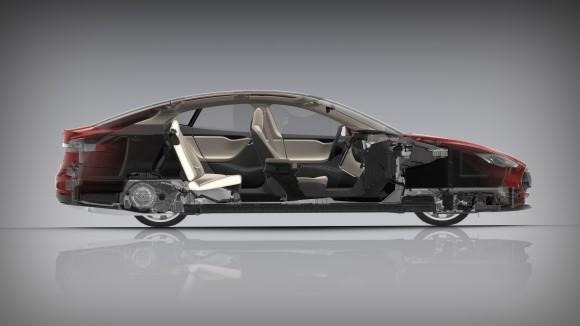Tesla's Elon Musk Tackles Model S Fire Head-On
Tesla's Elon Musk has commented publicly on the recent Model S fire that left one car partially destroyed and the company's stock tumbling, detailing the exact cause of the issue and arguing that the EV is still far safer than traditional gas-powered vehicles. The startup made headlines earlier this week when an owner's car in Seattle collided with a "large metallic object" and subsequently burst into flames, prompting speculation that it was less than safe. Far from that being the case, Musk says, it actually took a freak 25 ton impact to cause the fire.
Musk runs through the whole incident on the company blog, with a "curved section that fell off a semi-trailer" blamed for the issue. "The geometry of the object caused a powerful lever action as it went under the car, punching upward and impaling the Model S with a peak force on the order of 25 tons" the CEO writes. "Only a force of this magnitude would be strong enough to punch a 3 inch diameter hole through the quarter inch armor plate protecting the base of the vehicle."
The subsequent fire began in the front battery module but was contained by the internal firewalls within that module, Musk says. "Vents built into the battery pack directed the flames down towards the road and away from the vehicle" he points out; the fire department followed proper extinguishing procedure, punching holes in the top of the battery plate and feeding in water.
"It is important to note that the fire in the battery was contained to a small section near the front by the internal firewalls built into the pack structure" Musk highlights. "At no point did fire enter the passenger compartment."

Musk isn't shy about running through what could have potentially happened had it been a traditionally-powered car involved, not a battery-powered Model S. The thin metal underbody of the typical gas car, plus the fact that "the combustion energy of our battery pack is only about 10% of the energy contained in a gasoline tank and is divided into 16 modules with firewalls in between", means "the effective combustion potential is only about 1% that of the fuel in a comparable gasoline sedan" he calculates.
Tesla also shares correspondence between its service team and the Model S' owner, Robert Carlson, in which the shaken but still Tesla-loyal driver speaks of how keen he is to get back behind the wheel of a replacement car. "The batteries went through a controlled burn which the internet images really exaggerates" Carlson comments, going on to describe the incident as a "doomsday" test for the marque.
"For consumers concerned about fire risk," Musk concludes, "there should be absolutely zero doubt that it is safer to power a car with a battery than a large tank of highly flammable liquid."
Back in August, Tesla made NHTSA records with a clean sweep across the board in all of the safety testing categories.
